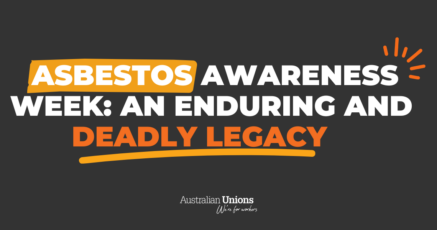Things don’t have to break before they can be fixed
The world is waking up to the importance of workers who feel supported, safe and satisfied.
Unfortunately, sometimes the business’s profitability drives this change in the workplace.
The purely profit-driven approach to mental health goes something like this: Happy workers are hard workers. Hard workers are productive workers. Productive workers are profitable workers.
This profit-driven approach to mental health in the workplace can result in some not-so-helpful attempts at providing ‘support’ to workers.
Table tennis tournaments on a Tuesday, pizza parties when the team’s drowning in work, a poster for lifeline on the staff room fridge, and maybe an email on R U OK? Day about the importance of meditating, yoga, or exercise. Basically, putting the onus on workers to help themselves.
But it doesn’t have to be like that. Not if we all work together to ensure workplaces actively facilitate good mental health practices – and removing practices that are unsafe for mental health – in the workplace from the get-go. In fact, it’s the law.
Your employer is legally obliged to provide a safe working environment
While the rest of the world was waking up, it took Australia longer to rise to the challenge. It wasn’t until May 2021 – after many years of campaigning from unions and mental health advocates – that state and federal ministers voted to update Australia’s work safety regulations to include psychological and social hazards at work.
Under the Occupational Health and Safety Act 2004, employers ‘must, so far as is reasonably practicable, provide and maintain a working environment that is safe and without risks to health.’
The term ‘health’ in the Act has been specifically defined to include both physical and psychological (i.e. mental) health. That means employers are legally obliged to minimise and eliminate mental health hazards in the workplace in the same way they’re required for physical hazards.
Sure, ‘complimentary’ breakfasts and gym access are great. But now, these regulations will ensure that employers must do more than just distracting, placative gestures.
Some of the mental health risks to keep in mind
Support is always available
-
Call 000 if you, a child, or another person is in immediate danger.
-
Call Lifeline on 1311 14 for free 24-hour telephone crisis support service in Australia.
-
Call BeyondBlue on 1300 22 4636 for counselling support around depression and anxiety.
You’ve heard it before, but prevention is always better than cure. But it can be challenging to spot mental health risks ahead of time and do something about them before it’s too late.
A 2021 report by Australian Unions lists 11 common psychological hazards in the workplace. Some of these hazards will be easy to identify in the workplace and typically have clear solutions. But some hazards can be more subtle – and even harder to address.
Let’s look at three of the less common hazards in more detail.
Does your job, duties, or tasks change without notice? Do multiple managers seem to have different ideas of what you’re supposed to do? Are you not even sure which manager you report to?
Low role clarity is when it’s not clear what your responsibilities are or what’s expected of you daily.
The boss wants those TPS reports by the end of the day? Fine. Except what’s a TPS report? And what about those client calls your team leader said were priority number one?
This kind of confusion and lack of confidence in your work can impact your mental health. It’s that feeling of being set up to fail or that you’re incapable of doing the right thing no matter how hard you work, and it leads to genuine anxiety and stress.
Unfortunately, low role clarity can be disguised by employers as a performance issue rather than an organisational failing. This only makes the anxiety worse for the impacted workers, and the real solutions harder to implement.
Do you feel isolated? Purposely separated from your colleagues? Are you worried that no one is around to help when something goes wrong?
Many people work alone, remotely or in isolation – long-haul truck drivers, shift workers and gig workers, health care workers, farmworkers and taxi or public transport drivers. The pandemic has made work of this nature even more common.
Some people prefer autonomy and even solitude. However, in an emergency, the inability to get immediate assistance from people or colleagues is a physical hazard. And the feeling of being alone in the face of danger or stress can be psychologically taxing.
With more people working from home, often alone and without proper support from employers, that same feeling of isolation is becoming even more common in industries that have typically been more social.
Are you anxious about confronting abusive customers? Has someone threatened to harm you while you were at work? Have you witnessed a traumatic event in the workplace?
Violent and traumatic events are still far too common in workplaces. Unfortunately, essential workers got to see and experience people in a less than favourable light during the pandemic.
When you’re exposed to abuse, threats, or actual harm – even just once – the fear and distress that comes with that can be debilitating. If it’s not treated, or better yet, prevented in the first place, then psychological harm is almost inevitable.
Trauma is incredibly complex, and no two people will experience it the same way. In fact, it doesn’t always only affect the people directly involved.
Secondary trauma, or vicarious trauma, can occur when someone sees, hears or is told about a traumatic event that may not involve them first-hand. It can happen to those who witness verbal or physical abuse directed at a coworker. To those required to watch and dissect security footage of distressing incidents. To those listening to a client recount a harrowing experience.
In some industries, the likelihood of being exposed to a traumatic incident is higher – it may even be ‘part of the job.’ That doesn’t mean there’s any less social, moral or legal responsibility to support workers who experience secondary trauma because of it.
Your psychological safety is serious business. Never make excuses for employers who don’t take it equally as seriously.







SHARE:
A discount on yoga classes doesn’t cut it: Three common signs of a mentally unhealthy workplace and how to fix it